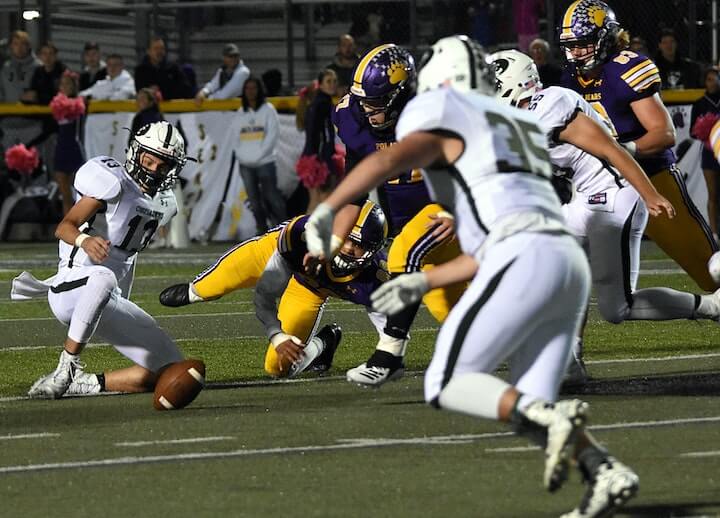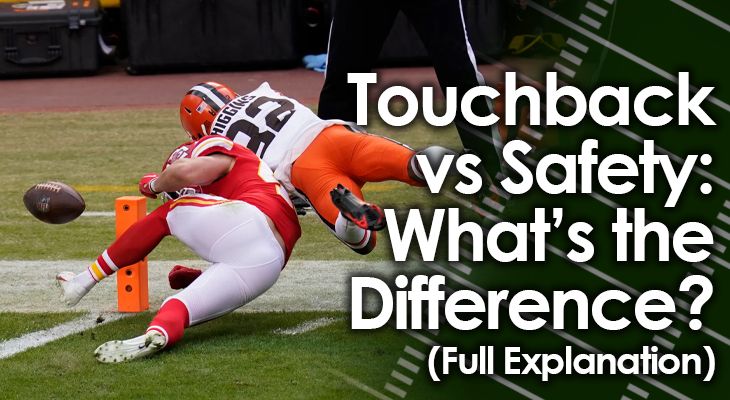There are a few plays in football that look similar, but actually have different outcomes -- one such comparison is a touchback vs safety.
In both of these plays, a player is either tackled or downed in their own end zone with possession of the football.
On one hand you have a touchback -- the team with the football gets an offensive possession started at their own 25-yard line.
On the other hand, a safety -- the team with the football not only loses possession of the football altogether, but the opposite team scores 2 points.
These are two dramatically different outcomes from plays that ultimately end in the same fashion.
So, what's the difference between a touchback vs safety?
Let's take a closer look at these two relatively similar plays in football that have significantly different outcomes.
Touchback
There are three main situations in football in which a touchback can occur:
- A kickoff
- A punt
- A turnover
We'll break down how all of these happen in a minute.
First, it's important to understand what a touchback is.
A touchback occurs any time one of the teams gets possession of the football from the other team.
That's why those three instances above are the only three in which a touchback can occur -- it signifies an official change of possession.
Touchback on Kickoffs
On a kickoff, a touchback can happen one of two ways:
- First, the kickoff team kicks the ball into the other end zone, and a player on the returning team downs it before he leaves the end zone.
- Second, if the kicker drills the ball through the end zone altogether -- no player needs to possess it for a touchback to occur in this case.
Touchback on Punts
The touchback rules for a punt are pretty much the same...
The only main difference is that referees will still call a touchback if a punted ball hits any part of the end zone.
On a kickoff, if the receiving team leaves the ball on the ground, it's considered a live ball.
In other words, the kicking team can recover the live ball as a fumble if no one on the receiving team gains possession of it.
Touchback on Turnovers
The final example is on a turnover.
If the defense either intercepts a pass or recovers a fumble in their own end zone, it's considered a touchback.
This occurs as long as the defender who takes possession of the football doesn’t advance it out of the end zone first.
If he does that and then goes back into his end zone, a touchback does not occur.

Safety
A safety happens anytime a ball carrier gets tackled or downed inside his own end zone.
In order for it to be a safety and not a touchback, the ball has to be in possession of a team outside of the end zone at some point during the play.
If both of those criteria are not met, then the play will be a touchback instead of a safety.
There are a few examples of when a safety occurs:
Safety on Offense
First, if the offense lines up deep in their own end zone, and the quarterback gets sacked in his own end zone.
Likewise, if a running back takes a handoff in this situation and gets tackled inside his own end zone, then a safety will also occur.
Safety on Defense
Another rarer example of a safety occurs during a turnover.
If the defense intercepts a ball in their own end zone, a safety can still happen.
If the defender advances the ball out of his end zone, and then -- on his own -- goes back into his end zone and gets tackled, a safety will be called.
This is because he gets tackled inside his own end zone after having possession of the ball outside of the end zone at some point in the play.

What Happens With a Touchback vs Safety?
Now that it's clear what differentiates a touchback from a safety, it's important to know what happens after each are called.
Touchback:
In the case of a touchback, the ref will call a dead ball.
He'll blow his whistle to signify the end of the play so that nobody gets hurt -- especially on kickoffs and punts.
Then, the receiving team of the kickoff or punt -- or the team that recorded the turnover -- will have their offense take over a new set of downs from their own 25-yard line.
This is why some kick and punt return teams will opt to down the ball in their own end zone. It could end up giving them better field possession than if they tried to return it.
Safety:
With a safety, the team that made the tackle will immediately get 2 points added to their score on the scoreboard. They will also get possession of the football, too.
What will happen here, though, is the team that was tackled in its own end zone will have the chance to "free kick" back to the other team.
They can either punt or kickoff from a tee for the change of possession.
The team that just scored 2 points will then have the chance to return the kick and start with a new set of downs on offense.
Conclusion
A touchback and safety are two very similar plays but have major differences in their outcomes.
One is a play that will result in the offense taking over from their own 25-yard line while the other results in a change of possession and 2 points scored for one team.
Understanding the rules of each is very important so players can avoid getting tackled for a safety.

